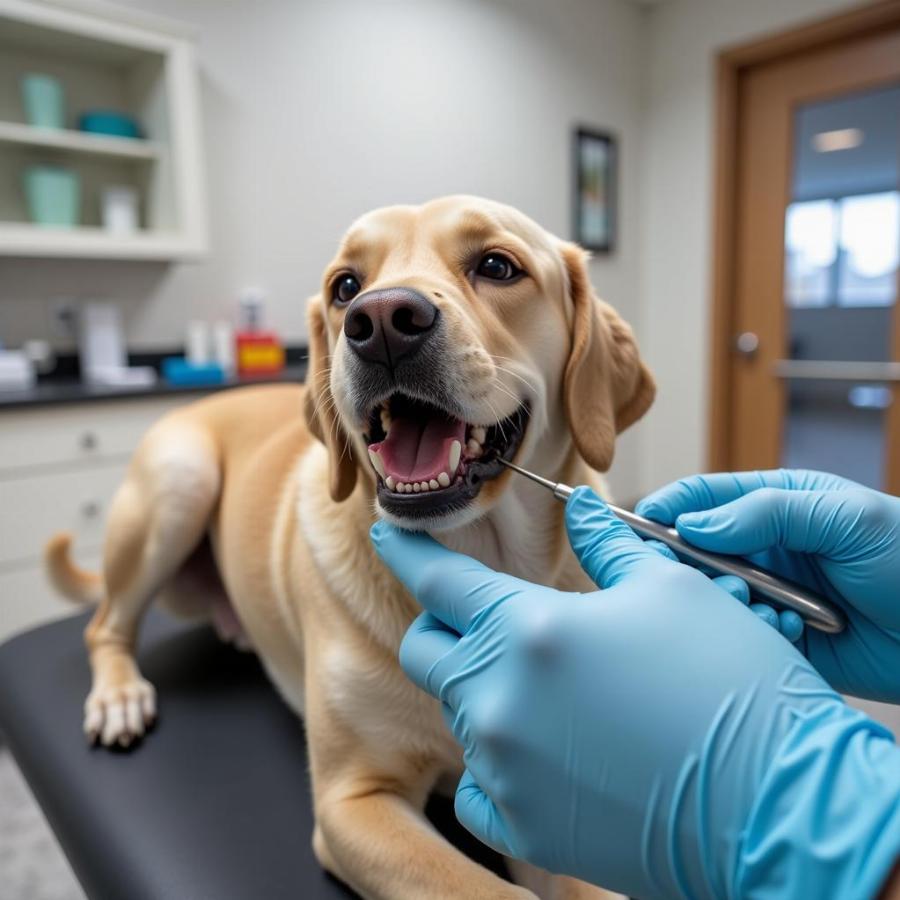Dog tartar, also known as calculus, is a common dental problem that occurs when plaque, a sticky film of bacteria, builds up on your dog’s teeth and hardens. If left untreated, tartar can lead to bad breath, gum disease, and even tooth loss. The good news is that you can take steps to get rid of dog tartar and prevent it from coming back. This comprehensive guide will cover everything you need to know about dog tartar, from the causes and symptoms to effective removal methods and prevention tips.
Understanding Dog Tartar: Causes and Symptoms
Just like in humans, plaque constantly forms on your dog’s teeth. If not removed regularly through brushing, it can react with saliva and minerals in your dog’s mouth to harden into tartar. This hard deposit is more than just unsightly; it harbors harmful bacteria that can wreak havoc on your furry friend’s oral health.
Here are some common signs that your dog might have tartar buildup:
- Bad breath: This is often the first and most noticeable sign of tartar buildup.
- Yellow or brown discoloration on teeth: Tartar typically appears as a yellowish or brownish deposit along the gum line.
- Red, inflamed gums (gingivitis): Tartar irritates the gums, leading to inflammation, redness, and swelling.
- Bleeding gums: You may notice blood on your dog’s chew toys or when you brush their teeth.
- Difficulty eating: In severe cases, tartar buildup can make it painful for dogs to eat, leading to loss of appetite and weight loss.
Effective Methods to Get Rid of Dog Tartar
If your canine companion is already suffering from tartar buildup, don’t worry! There are several effective methods to address the issue and restore their pearly whites:
1. Professional Dental Cleaning
The most effective way to remove tartar is through a professional dental cleaning performed by a veterinarian. This procedure involves a thorough examination of your dog’s mouth, followed by scaling and polishing under general anesthesia.
2. Home Dental Care Routine
While professional cleanings are essential, maintaining a consistent home dental care routine is crucial for preventing tartar buildup in the first place.
- Brushing: Just like us, dogs benefit from regular brushing. Aim to brush your dog’s teeth daily using a dog toothpaste and brush specifically designed for canine use.
- Dental Chews and Treats: Dental chews and treats are designed to help reduce plaque and tartar buildup through mechanical action. Look for options that are vet-approved and appropriate for your dog’s size and chewing habits.
3. Other Tartar Removal Products
In addition to brushing and dental chews, several other products can aid in tartar removal:
- Dental Wipes: These are a convenient alternative for days when brushing isn’t feasible.
- Water Additives: Dental water additives contain enzymes that help break down plaque and freshen breath.
- Dental Diets: Certain prescription diets are formulated with kibble shapes and textures that help clean teeth as your dog chews.
Preventing Tartar Buildup: Proactive Steps for a Healthy Smile
Preventing tartar buildup is always easier than treating it. By incorporating these proactive measures into your dog’s routine, you can help keep their teeth clean and healthy:
- Start Young: Introduce dental care practices early in your dog’s life to make it a positive experience.
- Schedule Regular Veterinary Checkups: Regular dental checkups allow your vet to monitor your dog’s oral health and address any potential issues early on.
- Provide a Balanced Diet: A balanced diet contributes to overall health, including dental health.
Frequently Asked Questions about Dog Tartar
Q: Can I use human toothpaste on my dog?
A: No, human toothpaste often contains ingredients like xylitol, which are toxic to dogs. Always use toothpaste specifically formulated for canine use.
Q: How often should I get my dog’s teeth professionally cleaned?
A: The frequency of professional cleanings varies depending on your dog’s breed, age, and overall oral health. Your veterinarian can recommend a suitable schedule.
Q: Are certain dog breeds more prone to tartar buildup?
A: Yes, smaller breeds and those with crowded teeth tend to be more susceptible to tartar buildup.
 Veterinarian Examining Dog Teeth
Veterinarian Examining Dog Teeth
Conclusion
Taking care of your dog’s teeth is a vital part of responsible pet ownership. By understanding the causes of tartar buildup and implementing effective removal and prevention strategies, you can help your furry friend maintain a healthy smile for years to come. Remember, regular brushing, professional cleanings, and a proactive approach to dental care are key to keeping your dog’s teeth clean, healthy, and tartar-free.
Need More Help with Your Canine Companion’s Dental Health?
Beaut Dogs is your go-to resource for all things related to dog care. We offer a wealth of information on dog breeds, health, nutrition, and training. If you have any questions or need further assistance, our team of experts is here to help. Contact us at [email protected] for personalized advice and guidance. Your dog’s well-being is our top priority!